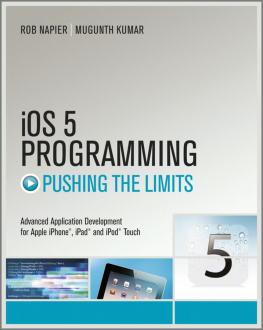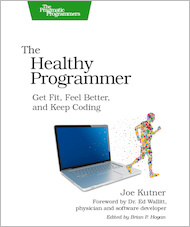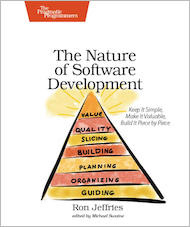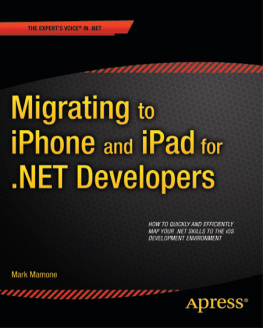Pushing the Limits with iOS 5 Programming
Advanced Application Development for Apple iPhone, iPad, and iPod Touch
Rob Napier and Mugunth Kumar

This edition first published 2012
2012 John Wiley and Sons, Ltd.
Registered office
John Wiley & Sons Ltd, The Atrium, Southern Gate, Chichester, West Sussex, PO19 8SQ, United Kingdom
For details of our global editorial offices, for customer services and for information about how to apply for permission to reuse the copyright material in this book please see our website at www.wiley.com.
The right of the author to be identified as the author of this work has been asserted in accordance with the Copyright, Designs and Patents Act 1988.
All rights reserved. No part of this publication may be reproduced, stored in a retrieval system, or transmitted, in any form or by any means, electronic, mechanical, photocopying, recording or otherwise, except as permitted by the UK Copyright, Designs and Patents Act 1988, without the prior permission of the publisher.
Wiley also publishes its books in a variety of electronic formats. Some content that appears in print may not be available in electronic books.
Designations used by companies to distinguish their products are often claimed as trademarks. All brand names and product names used in this book are trade names, service marks, trademarks or registered trademarks of their respective owners. The publisher is not associated with any product or vendor mentioned in this book. This publication is designed to provide accurate and authoritative information in regard to the subject matter covered. It is sold on the understanding that the publisher is not engaged in rendering professional services. If professional advice or other expert assistance is required, the services of a competent professional should be sought.
Trademarks: Wiley and the John Wiley & Sons, Ltd. logo are trademarks or registered trademarks of John Wiley and Sons, Ltd. and/ or its affiliates in the United States and/or other countries, and may not be used without written permission. iPhone, iPad and iPod are trademarks of Apple Computer, Inc. All other trademarks are the property of their respective owners. John Wiley & Sons, Ltd. is not associated with any product or vendor mentioned in the book. This book is not endorsed by Apple Computer, Inc.
A catalogue record for this book is available from the British Library.
ISBN 978-1-119-96132-1 (paperback); ISBN 978-1-119-96158-1 (ebook); 978-1-119-96159-8 (ebook); 978-1-119-96160-4 (ebook)
Set in 9.5/12 Myriad Pro Regular by Wiley Composition Services
Printed in the United States by Bind-Rite
Dedication
To Neverwood. Thanks for your patience.
Rob
To my mother who shaped the first twenty years of my life
Mugunth
Publishers Acknowledgements
Some of the people who helped bring this book to market include the following:
Editorial and Production
VP Consumer and Technology Publishing Director: Michelle Leete
Associate DirectorBook Content Management: Martin Tribe
Associate Publisher: Chris Webb
Acquisitions Editor: Chris Katsaropolous
Assistant Editor: Ellie Scott
Development Editor: Tom Dinse
Copy Editor: Maryann Steinhart
Technical Editor: Mithilesh Kumar
Editorial Manager: Jodi Jensen
Senior Project Editor: Sara Shlaer
Editorial Assistant: Leslie Saxman
Marketing
Associate Marketing Director: Louise Breinholt
Marketing Executive: Kate Parrett
Composition Services
Compositor: Wiley Indianapolis Composition Services
Proofreaders: Laura Albert, Lindsay Amones, Melissa D. Buddendeck, Melissa Cossell
Indexer: Potomac Indexing, LLC
About the Authors
Rob Napier is a builder of tree houses, hiker, and proud father. He began developing for the Mac in 2005, and picked up iPhone development when the first SDK was released, working on products such as The Daily, PandoraBoy, and Cisco Mobile. He is a major contributor to Stack Overflow and maintains the Cocoaphony blog (cocoaphony.com).
Mugunth Kumar is an independent iOS developer based in Singapore. He graduated in 2009 and holds a Masters degree from Nanyang Technological University, Singapore, majoring in Information Systems. He writes about mobile development, software usability, and iOS-related tutorials on his blog (blog.mugunthkumar.com).Prior to iOS development he worked for Fortune 500 companies GE and Honeywell as a software consultant on Windows and .NET platforms. His core areas of interest include programming methodologies (Object Oriented and Functional), mobile development and usability engineering. If he were not coding, he would probably be found at some exotic place capturing scenic photos of Mother Nature.
About the Technical Editor
Mithilesh Kumar is a software engineer with a passion for user interface design, Internet protocols, and virtual worlds. He likes to prototype and build applications for iOS and Mac OS X platforms. He has extensive experience in developing UI and core components for telephony clients capable of voice, video, instant messaging, presence, and voicemail.
Mithilesh graduated with a Masters degree in Computer Science from Virginia Tech with emphasis on Human-Computer Interaction. While at graduate school, he co-authored several research papers in the area of user interfaces, computer graphics and network protocols.
Authors Acknowledgements
Rob thanks his family for giving up many evenings that he spent in the basement writing, hacking, and otherwise failing to come upstairs. Mugunth thanks his parents and friends for their support while writing this book. Thanks to Wiley for making this book possible. It went extremely well, particularly due to Sara Shlaers continual guiding hand. Thanks to Mithilesh Kumar who made sure what we said was true, and Tom Dinse who made sure that it was intelligible. Thanks to Chris Katsaropoulos for first reaching out and getting this project rolling. Thanks to the Apple engineers who answer questions on development forums on all those still-under-NDA issues, and the whole iOS developer community who share so much. And special thanks to Steve Jobs for building toys we could build a career around.
Introduction
Apple has a history of alternating its releases between user-focus and developer-focus. The good news about iOS 5 is that its all about the developers. The addition of Automatic Reference Counting (ARC) alone is worth the upgrade for developers. In one move, Apple has eliminated the number one cause of crashes in iOS applications, while making the code easier to write and faster to run. Moving to ARC is the single best thing you can do for your application. Its the most important Objective-C feature since the autorelease pool.
But iOS 5 adds many more features for the developer. From iCloud to automatic data protection, the operating system now takes care of more of the hard problems, letting developers focus on making the best apps.
Most visible to developers is the new Xcode. Some of it is better, some of it is just different, and some of it will make you crazy. Its the new game in town, though, and everyone needs to get used to it. This book will help you figure it out.
If youre ready to take on the newest Apple release and push your application to the limits, this is the book to get you there.
Who This Book Is For
This is not an introductory book. There are many books out there that will teach you Objective-C and take you step by step through Interface Builder. This is not that book. This book assumes that you have a little experience with iOS. Maybe youre self-taught, or maybe youve taken a class. Youve hopefully written at least most of an application, even if you havent submitted it yet. If youre ready to move beyond the basics, to learn the best practices and the secrets that the authors have learned from practical experience writing real applications, then this is the book for you.












